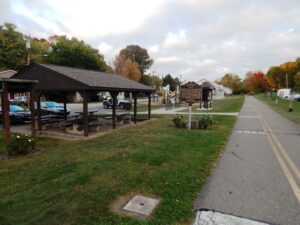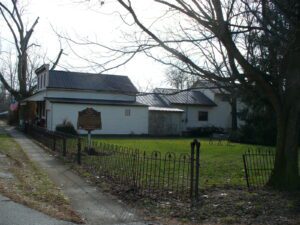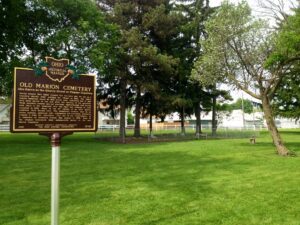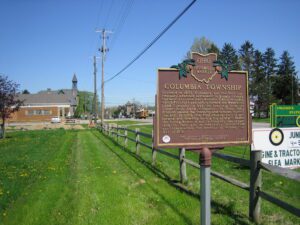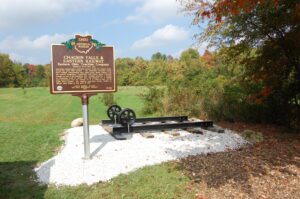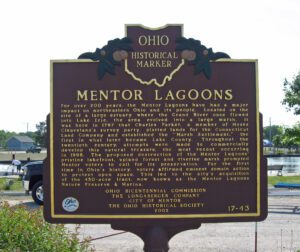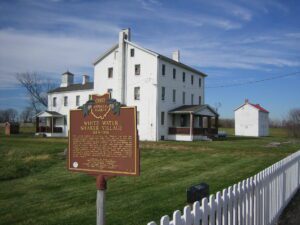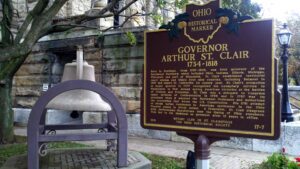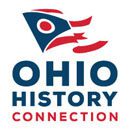, OH
Deerfield was laid out around 1795 and in 1802 Major Benjamin Stites, his son Benjamin, Jr., and John Gano officially recorded the village’s plat. A part of the great tide of Americans moving into the Northwest Territory (and Ohio after 1803), Deerfield’s early inhabitants included Revolutionary war veteran Ephraim Kibbey as well as Andrew Lytle, Nathan Kelly, William Snook, and War of 1812 veteran David Sutton. Deerfield was so called because it was a settlement in Deerfield Township, Hamilton County in the 1790s. (Continued on other side)
, OH
The foundation for the first Welsh settlement in Ohio was laid on June 29, 1801, when William and Morgan Gwilym purchased land in what is now Morgan Township at the Cincinnati Land Office. The Welsh, who settled in Pennsylvania beginning in the late eighteenth century, moved westward and settled here in 1802. This area was also the major terminus for the 1818 migration from Montgomeryshire and Cardiganshire in Wales. In 1803 a Congregational Church was organized and services were held in members’ homes or outdoors. A brick Meetinghouse, complete with a Welsh death door leading to the cemetery, was constructed in 1824. The building now serves as the Community House. The present brick church was built in 1854. For many years, the library, formed in 1852, was housed in the New London Special School District building that stood on this site. (Continued on other side)
, OH
Marion founder Eber Baker donated this two-acre plot for use as a cemetery shortly after platting the village in 1822. The oldest legible headstone bears an 1812 burial date, indicating that it may have been moved to the site after the opening of the cemetery. While complete records are not available, approximately 200 burials took place in the cemetery with the final one believed to have occurred in 1872. Many of the 65 victims of an 1854 cholera outbreak were buried here. The cemetery’s location next to an active railroad, combined with unfavorable soil conditions, eventually created a need for relocation. This led to the establishment of a cememtery on Delaware Avenue that opened in 1858. Many of the original internments were subsequently moved to the new Marion Cemetery.
, OH
Founded in 1807, Columbia was the first continuously inhabited settlement in Lorain County. Harmon, Levi and Azor Bronson, Calvin Hoadley, Jared Pritchard and others formed the Waterbury Land Company to buy the township from the Connecticut Land Company. In 1808, Sally Bronson named the township and became its first teacher. In 1809, the first church society was formed and Hoadley built a log gristmill beside the Rocky River. A militia company was organized in 1810 and a two-story blockhouse was constructed for protection during the War of 1812.
, OH
From east to west, the Chagrin Falls and Eastern Interurban Railway crossed the Muggleton Farm (now South Russell Village Park) at this location and connected the Chagrin Valley with Hiram, Garrettsville, and Middlefield. Its sister interurban, the Cleveland and Chagrin Falls Electric Railway served points west. Soon after their formation, the Everett-Moore Syndicate merged the two lines into the extensive interurban rail network, The Eastern Ohio Traction Company. The EOTC and its predecessors operated from 1899-1925, mainly moving mail, farm goods, and passengers. In 1914, the more rural line from Chagrin Falls traveling eastward became the first major interurban in the United States to cease operations. It is believed that declining use, insufficient power for the railway, and a failed line extension to Youngstown were likely factors contributing to the line’s demise.(Continued on other side)
, OH
For over 200 years, the Mentor Lagoons have had a major impact on northeastern Ohio and its people. Located on the site of a large estuary where the Grand River once flowed into Lake Erie, the area evolved into a large marsh. It was here in 1797 that Charles Parker, a member of Moses Cleaveland’s survey party, platted lands for the Connecticut Land Company and established the “Marsh Settlement,” the first in what later became Lake County. Throughout the twentieth century, attempts were made to commercially develop this natural treasure, the most recent occurring in 1996. The proposed destruction of the Mentor Lagoons’ pristine lakefront, upland forest and riverine marsh prompted Mentor voters to call for its preservation. For the first time in Ohio’s history, voters affirmed eminent domain action to protect open space. This led to the city’s acquisition of the 450-acre tract, now known as the Mentor Lagoons Nature Preserve & Marina.
, OH
The United Society of Believers (or “Shakers,” as they are commonly known) established White Water, the last of four Ohio Shaker villages, in 1824. White Water flourished throughout the nineteenth and early twentieth centuries. At its peak during the 1850s, 150 Believers living in three semi-autonomous Shaker “families” farmed 1,300 acres of land in Crosby and adjacent Morgan townships. The Shakers were among the most successful religious societies in the United States. Belief in the equality of men and women, separation of the sexes, celibacy, communal ownership of property, and a distinctive style of worship — characterized by rhythmic movements and shaking — helped define the Shaker lifestyle. (Continued on other side)
, OH
Born in Scotland. From 1787-1802, was first governor of the Northwest Territory, which included Ohio, Indiana, Illinois, Michigan, Wisconsin and part of Minnesota. St. Clair established territorial court system and Ohio’s first nine counties, including Belmont in 1801 and named St. Clairsville its county seat. St. Clair’s promotion to major general in 1777 recognized his exemplary service to Washington in New Jersey during American victories at the battles of Trenton and Princeton. St. Clair was a delegate to Congress under Articles of Confederation in 1786 and in 1787 was its president when it adopted the Northwest Ordinance and authorized the convention that wrote the U.S. Constitution. His 1791 attempt to break Indian resistance to American settlement in the Ohio Country ended in bitter defeat. A Federalist, St. Clair disagreed with Jeffersonian-Republicans over the timing of Ohio statehood. This led to his dismissal as governor after 15 years in office.


